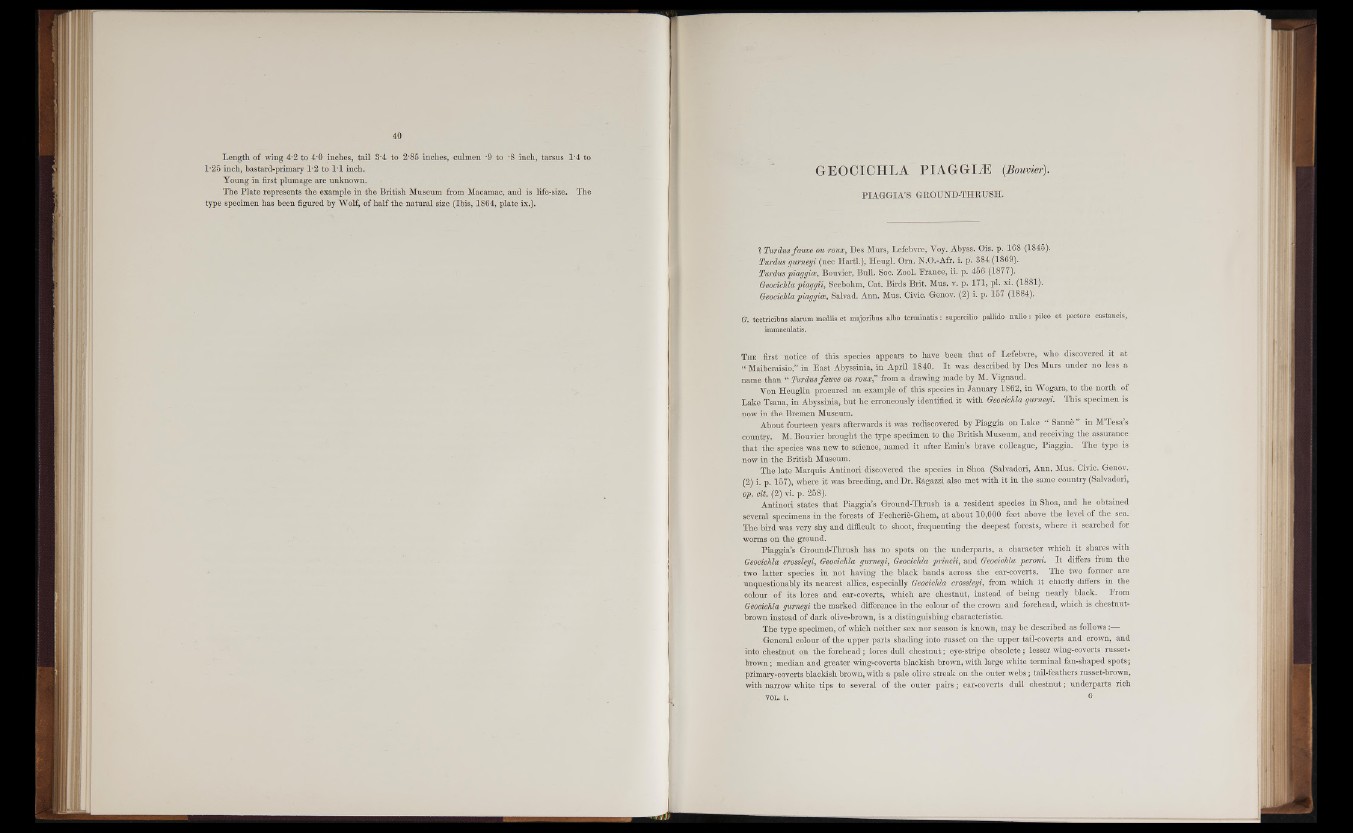
Length of wing 4*2 to 4*0 inches, tail 3*4 to 2*85 inches, culmen *9 to ’8 inch, tarsus 1*4 to
L25 inch, bastard-primary L2 to 1*1 inch.
Young in first plumage are unknown.
The Plate represents the example in the British Museum from Macamac, and is life-size. The
type specimen has been figured by Wolf, of half the natural size (Ibis, 1864, plate ix.).
PIAGGIA’S GROUND-THRUSH.
% Turdusfauve ou roux, Des Murs, Lefebvre, Yoy. Abyss. Ois. p. 168 (1845).
Turdus gurneyi (nec Hartl.), Heugl. Om. N.O.-Afr. i. p. 384 (1869).
Turdus piaggice, Bouvier, Bull. Soc. Zool. France, n. p. 456 (1877).
Geocichla piaggii, Seebohm, Cat. Birds Brit. Mus. v. p. 171, pi. xi. (1881).
Geocichla piaggice, Salvad. Ann. Mus. Civic. Genov. (2) i. p. 157 (1884).
G. tectricibus alarum mediis et majoribus albo terminatis: supercilio pallido nullo: pileo et pectore castaneis,
immaculatis.
T he first notice of this species appears to have been that of Lefebvre, who discovered it at
“ Maiberaisio,” in East Abyssinia, in April 1840. It was described by Des Murs under no less a
name than “ Turdusfauve ou roux” from a drawing made by M. Vignaud.
Yon Heuglin procured an example of this species in January 1862, in Wogara, to the north of
Lake Tsana, in Abyssinia, but he erroneously identified it with Geocichla gurneyi. This specimen is
now in the Bremen Museum.
About fourteen years afterwards it was rediscovered by Piaggia on Lake “ Sanne ” in M’Tesa’s
country. M. Bouvier brought the type specimen to the British Museum, and receiving the assurance
that the species was new to science, named it after Emin’s brave colleague, Piaggia. The type is
now in the British Museum.
The late Marquis Antinori discovered the species in Shoa (Salvadori, Ann. Mus. Civic. Genov.
(2) i. p. 157), where it was breeding, and Dr. R&gazzi also met with it in the same country (Salvadori,
op. cit. (2) vi. p. 258).
Antinori states that Piaggia’s Ground-Thrush is a resident species in Shoa, and he obtained
several specimens in the forests of Fecherie-Ghem, at about 10,000 feet above the level of the sea.
The bird was very shy and difficult to shoot, frequenting the deepest forests, where it searched for
worms on the ground.
Piaggia’s Ground-Thrush has no spots on the underparts, a character which it shares with
Geocichla crossleyi, Geocichla gurneyi, Geocichla princii, and Geocichla peroni. It differs from the
two latter species in not having the black bands across the ear-coverts. The two former are
unquestionably its nearest allies, especially Geocichla crossleyi, from which it chiefly differs in the
colour of its lores and ear-coverts, which are chestnut, instead of being nearly black. From
Geocichla gurneyi the marked difference in the colour of the crown and forehead, which is chestnut-
brown instead of dark olive-brown, is a distinguishing characteristic.
The type specimen, of which neither sex nor season is known, may be described as follows:—
General colour of the upper parts shading into russet on the upper tail-coverts and crown, and
into chestnut on the forehead; lores dull chestnut; eye-stripe obsolete; lesser wing-coverts russet-
brown ; median and greater wing-coverts blackish brown, with large white terminal fan-shaped spots;
primary-coverts blackish brown, with a pale olive streak on the outer w ebs; tail-feathers russet-brown,
with narrow white tips to several of the outer pairs; ear-coverts dull chestnut; underparts rich
v o l . I . G